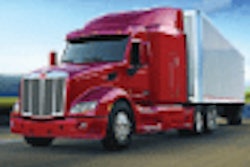Freightliner Custom Chassis Corporation (FCCC) is delivering 40 hydraulic hybrid power walk-in vans to UPS.
Developed in partnership with Parker Hannifin Corporation, FCCC hydraulic hybrid vehicles (HHVs) use hydraulic high pressure to propel the vehicle with the engine off, reducing fuel consumption by up to 40 percent.
Georgia-based UPS will deploy 20 of the HHVs in the Baltimore area and 20 in the Atlanta area. Both deployments are in partnership with the U.S. Department of Energy’s Clean Cities program.
“We are excited about this technology and UPS’s decision to make it part of their fleet,” said Mike Stark, FCCC senior technical sales manager, national accounts. “In terms of fuel economy, range and performance, the HHV is ideal for challenging pickup and delivery routes like those served by UPS. It supports the levels of productivity and profitability that fleets have come to expect from walk-in vans built on FCCC chassis.”
The HHV uses energy stored in its hydraulic high-pressure accumulator to propel the vehicle with zero fuel consumption and zero emissions. Continued stop-and-go operation of the vehicle recharges the hydraulic system. The diesel engine engages only when the hydraulic pressure drops below the threshold needed for operation.
This constant cycling allows the HHV to achieve a significant fuel economy improvement over traditional diesel-powered vehicles that use automatic transmissions in stop-and-go applications.
In addition to powering the vehicle engine, the hydraulic system also starts the engine, eliminating the need for a 12-volt starter. The system powers the HHV’s brakes and steering components as well, thus eliminating the need for the engine to support these vehicle functions.
A mechanical connection from the engine to the rear axle allows for an efficient power transfer during highway-speed operation.
In addition to its highly efficient dual-mode operating system of using both the engine and hydraulic energy in series to propel the vehicle, the HHV offers three other modes of operation.
The first mode, brake energy recovery, captures and returns more than 70 percent of the vehicle’s braking energy for use in engine operation.
Optimized engine control, the second mode, decouples the engine from the drive wheels, allowing it to operate at maximum efficiency.
The third mode is engine-off strategy. It relies on stored hydraulic power to operate the vehicle at low speeds, shutting the engine off completely to reduce emissions and fuel consumption.
The HHV’s regenerative braking system, which recaptures energy lost through the friction of normal brake pad activation, reduces brake wear and increases brake life by up to four times over a standard, non-hybrid chassis.
Built on FCCC’s reliable and durable MT-55 chassis, the HHV carries a gross vehicle weight rating (GVWR) of 20,500 to 27,000 lbs.
“There is virtually no difference in driver operation and no sacrifice to performance or to the other benefits of a walk-in van,” said Gordie Taylor, FCCC commercial chassis product manager. “With its maneuverability, interior cargo access, and safer, easier driver ingress and egress, the HHV has all the advantages of other FCCC walk-in vans, with the critical added advantages of increased fuel efficiency and reduced environmental impact.”
“Our long-term goal is to minimize our dependence on foreign energy, and one way we will get there is through the deployment of a wide variety of technologies and designs in our fleet,” said Mike Britt, UPS director of vehicle engineering. “As early adopters of this technology, we are very pleased with the significant fuel economy and emission reductions that come from the HHVs.”










